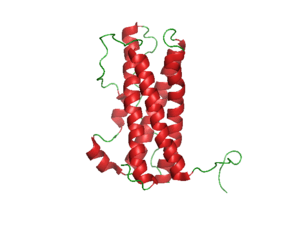Hypoprolactinemia
| Hypoprolactinemia | |
|---|---|
 | |
| Prolactin | |
| Classification and external resources |
Hypoprolactinemia is a medical condition characterized by a deficiency in the serum levels of the hypothalamic-pituitary hormone prolactin.[1][2]
Causes
Hypoprolactinemia can result from autoimmune disease,[2] hypopituitarism,[1] growth hormone deficiency,[2] hypothyroidism,[2] excessive dopamine action in the tuberoinfundibular pathway and/or the anterior pituitary, and ingestion of drugs that activate the D2 receptor, such as direct D2 receptor agonists like bromocriptine and pergolide, and indirect D2 receptor activators like amphetamines (through the induction of dopamine release).[3]
Diagnosis
Guidelines for diagnosing hypoprolactinemia are defined as prolactin levels below 3 µg/L in women,[4][5] and 5 µg/L in men.[6][7][8]
Symptoms
Hypoprolactinemia is associated with ovarian dysfunction in women,[4][5] and metabolic syndrome,[9] anxiety symptoms,[9] arteriogenic erectile dysfunction,[10] premature ejaculation,[6] oligozoospermia (low concentration of sperm in semen), asthenospermia (reduced sperm motility), hypofunction of seminal vesicles, and hypoandrogenism in men.[7] In one study, normal sperm characteristics were restored when prolactin levels were brought up to normal values in men with hypoprolactinemia.[8]
Hypoprolactinemia can be a cause of lactation failure after childbirth.[1][11][12]
See also
References
- 1 2 3 Jerome F. Strauss III; Robert L. Barbieri (28 August 2013). Yen & Jaffe's Reproductive Endocrinology: Physiology, Pathophysiology, and Clinical Management. Elsevier Health Sciences. pp. 53–. ISBN 978-1-4557-5972-9.
- 1 2 3 4 Andrew S. Davis (25 October 2010). Handbook of Pediatric Neuropsychology. Springer Publishing Company. pp. 1134–. ISBN 978-0-8261-5737-9.
- ↑ Trevor W. Stone (9 May 1996). CNS Neurotransmitters and Neuromodulators. CRC Press. pp. 214–. ISBN 978-0-8493-7632-0.
- 1 2 Kauppila A, Martikainen H, Puistola U, Reinilä M, Rönnberg L (Mar 1988). "Hypoprolactinemia and ovarian function". Fertil Steril. 49 (3): 437–41. PMID 3342895.
- 1 2 Schwärzler P, Untergasser G, Hermann M, Dirnhofer S, Abendstein B, Berger P (Oct 1997). "Prolactin gene expression and prolactin protein in premenopausal and postmenopausal human ovaries". Fertil Steril. 68 (4): 696–701. doi:10.1016/S0015-0282(97)00320-8. PMID 9341613.
- 1 2 Corona G, Mannucci E, Jannini EA, Lotti F, Ricca V, Monami M, Boddi V, Bandini E, Balercia G, Forti G, Maggi M (May 2009). "Hypoprolactinemia: a new clinical syndrome in patients with sexual dysfunction". J Sex Med. 6 (5): 1457–66. doi:10.1111/j.1743-6109.2008.01206.x. PMID 19210705.
- 1 2 Gonzales GF, Velasquez G, Garcia-Hjarles M (1989). "Hypoprolactinemia as related to seminal quality and serum testosterone". Arch. Androl. 23 (3): 259–65. doi:10.3109/01485018908986849. PMID 2619414.
- 1 2 Ufearo CS, Orisakwe OE (September 1995). "Restoration of normal sperm characteristics in hypoprolactinemic infertile men treated with metoclopramide and exogenous human prolactin". Clin Pharmacol Ther. 58 (3): 354–9. doi:10.1016/0009-9236(95)90253-8. PMID 7554710.
- 1 2 Corona, Giovanni; Mannucci, Edoardo; Jannini, Emmanuele A; Lotti, Francesco; Ricca, Valdo; Monami, Matteo; Boddi, Valentina; Bandini, Elisa; Balercia, Giancarlo; Forti, Gianni; Maggi, Mario (2009). "Hypoprolactinemia: A New Clinical Syndrome in Patients with Sexual Dysfunction". Journal of Sexual Medicine. 6 (5): 1457–1466. doi:10.1111/j.1743-6109.2008.01206.x. ISSN 1743-6095. PMID 19210705.
- ↑ Pituitary Hormones—Advances in Research and Application: 2013 Edition. ScholarlyEditions. 21 June 2013. pp. 62–. ISBN 978-1-4816-7922-0.
- ↑ Prabhakar VK, Shalet SM (2006). "Aetiology, diagnosis, and management of hypopituitarism in adult life". Postgrad Med J. 82 (966): 259–66. doi:10.1136/pgmj.2005.039768. PMC 2585697
 . PMID 16597813.
. PMID 16597813. - ↑ Robert F. Dons; Frank H. Wians, Jr. (17 June 2009). Endocrine and Metabolic Disorders: Clinical Lab Testing Manual, Fourth Edition. CRC Press. pp. 103–. ISBN 978-1-4200-7936-4.